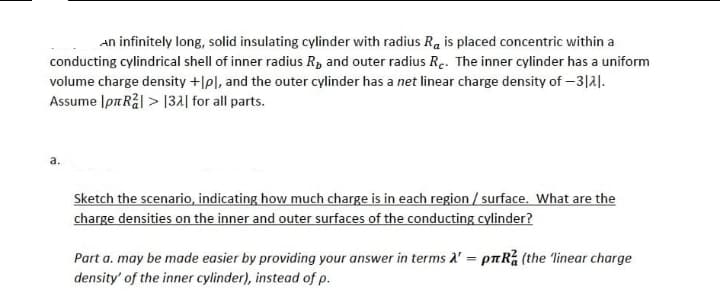An infinitely long, solid insulating cylinder with radius Ra is placed concentric within a conducting cylindrical shell of inner radius R₂ and outer radius Re. The inner cylinder has a uniform volume charge density +[p], and the outer cylinder has a net linear charge density of -3121. Assume [pлR> [32] for all parts. a. Sketch the scenario, indicating how much charge is in each region/surface. What are the charge densities on the inner and outer surfaces of the conducting cylinder?
An infinitely long, solid insulating cylinder with radius Ra is placed concentric within a conducting cylindrical shell of inner radius R₂ and outer radius Re. The inner cylinder has a uniform volume charge density +[p], and the outer cylinder has a net linear charge density of -3121. Assume [pлR> [32] for all parts. a. Sketch the scenario, indicating how much charge is in each region/surface. What are the charge densities on the inner and outer surfaces of the conducting cylinder?
Related questions
Question

Transcribed Image Text:An infinitely long, solid insulating cylinder with radius Ra is placed concentric within a
conducting cylindrical shell of inner radius R, and outer radius Re. The inner cylinder has a uniform
volume charge density +[pl, and the outer cylinder has a net linear charge density of -3121.
Assume Ip Rål> 132 for all parts.
a.
Sketch the scenario, indicating how much charge is in each region/surface. What are the
charge densities on the inner and outer surfaces of the conducting cylinder?
Part a. may be made easier by providing your answer in terms A' = pRa (the 'linear charge
density' of the inner cylinder), instead of p.
Expert Solution
This question has been solved!
Explore an expertly crafted, step-by-step solution for a thorough understanding of key concepts.
Step by step
Solved in 2 steps with 1 images
